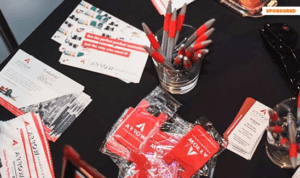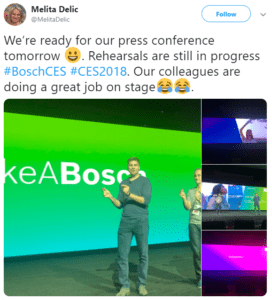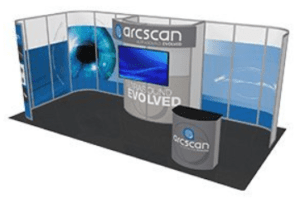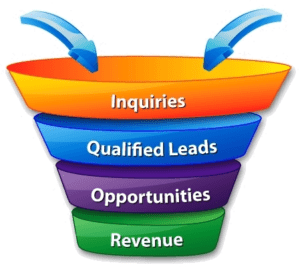Trade Show Marketing Strategy: What to Do Before, During, and After

Developing international markets is not an easy process. While there are many ways to identify and enter markets, all pathways require significant time and financial resources to get market traction. Participating in trade shows is a common choice for businesses exploring new export destinations since it has a relatively low price point and companies can easily find trade events oriented towards their industry and target clients.
Developing a trade show marketing strategy can further enhance your success at international business events. What does your trade show strategy look like?
Although many Canadian companies understand the importance of participating in international trade shows, not all deploy a trade show marketing strategy. Maintaining a plan for marketing your business before, during, and after the trade show can help boost your return on investment and lead to greater success in the chosen market. It can even help your business access trade show grants! If participating in international trade shows, your company must consider how to address these promotional opportunities.
Trade Show Marketing Strategies: Before the Show
Before travelling to your export market to participate in the trade show, your business should be committed to marketing itself and the trade event. Make sure to boost your visibility by leveraging technology and your network of clients and strategic partners! Some of the best pre-trade show marketing strategies include:
 Social Media
Social Media
Event organizers use social media to market their trade shows and conferences; you should use this momentum to showcase your business too! Using event-specific hashtags is the easiest way to achieve this. Since most social media sites use hashtags, search these platforms for hashtags relevant to the event and post content using those hashtags to build awareness.
Blog/Website Promotion
Your company’s website is another great platform to let clients and leads know where you’ll be exhibiting. Developing a blog that mentions the event and links to its registration page will help more traffic flow to the event, and they’ll be looking specifically for your business while in attendance! If your website maintains an events page that lists your upcoming marketing/sales-oriented sessions, this is also a great place to generate more awareness.
Direct Mail
With many marketing strategies going digital, there’s potentially more opportunity to drive success with direct mail than ever before. Using traditional marketing mediums like direct mail cuts through the clutter of online promotions and engages your target audience, especially those who are not connected with you online. Developing a postcard-sized mailer and sending it out to a well-segmented list can deliver great results and ensure people know you’ll be in their area and can be engaged with personally if they attend the trade show.
 Booth Design
Booth Design
The most typical consideration that companies must face is trade show booth display. Whether you design the booth in-house or hire an external consulting and design firm to take on this portion of the project, there are many considerations to make. First, you’ll want to start with your team’s objective for the trade show. While service-oriented firms may opt for a smaller, more intimate experience through their booth design, product sellers may want a booth display that more closely resembles a retail store with shelves and other transaction-focused props.
Trade Show Marketing Strategies: During the Show
Once at the trade show, there are some strategies your business can use to draw more visitors and convert them into customers. While your company representatives/ambassadors will contribute towards marketing and sales efforts during the show, there should be elements of your setup that passively generate interest and draw visitors to your booth. Some of the best marketing strategies to deploy during trade shows include:
Product Information Handouts
One of the easiest ways to give leads something tangible at your booth is to supply them with marketing and sales materials. Effective trade show handouts are often one or two pages long and focus on particular topics of interest to your visitors. The more personalized this information is, the more likely leads are to hang on to the information and recall it after the event. You can also develop trade show marketing materials that provide a high-level overview of your company, but make sure that you provide options that let visitors choose the type of information that they take with them.
Promotional Product Giveaways
 Everybody loves swag, right!? Free merchandise, often including a company logo or other brand identification, can help booth visitors remember your company and booth setup long after the trade show is finished. Making these freebies related to your brand or product/service offering can further solidify the visitor’s comprehension of what your company does and the value behind it – just watch out for trade show visitors that hop from booth to booth loading up on bags of giveaway items.
Everybody loves swag, right!? Free merchandise, often including a company logo or other brand identification, can help booth visitors remember your company and booth setup long after the trade show is finished. Making these freebies related to your brand or product/service offering can further solidify the visitor’s comprehension of what your company does and the value behind it – just watch out for trade show visitors that hop from booth to booth loading up on bags of giveaway items.
Free merchandise is best used if integrated into a sales conversation where the lead is actively engaged with a company representative. There should be no free merchandise given away – you should structure your promotional items to be given away after there is information collected on a lead, or there are other signals that they have an interest in doing business with your company.
Feel free to get as creative as possible in your merchandise giveaways; highly-visible and engaging activities, games, raffles, and contests will draw additional visitors to your booth while helping them to remember your company once the trade show is done. Merchandise promotional activities that are big, bright, and loud can help lead to success – just make sure you’re attracting the right types of visitors who have a genuine interest in your products or services.
Merchandise and Point of Sale Interaction
With most trade shows and conferences supporting sales enablement while at the event, be prepared to generate real sales. You don’t need to be a retailer with shelves full of merchandise to make sales at conferences, but you do need to be equipped to take payment and follow-up with customers afterwards. Mobile credit card readers are fairly inexpensive to purchase and generate a record of transactions, which makes it a go-to technology for any company participating in trade shows. Enabling transactions at your booth helps reduce barriers for interested parties and provides great data to analyze and determine how successful the event was.
Trade Show Marketing Strategies: After the Show
The trade show might be done, but there are still many great marketing opportunities to take advantage of. Keeping momentum with your leads and clients after the trade show is critical to long-term success; fortunately, it’s one of the areas where marketing strategies can be used most effectively. Some of the best marketing strategies to deploy after trade shows include:
Sales and Lead Evaluation
Your marketing and sales teams should meet after a trade show to filter through leads and customers gained during the event. Build multiple lists that identify audience segments such as those who visited the booth and talked to a company representative, those that made purchases, or those who entered a contest/raffle with their business card. Specifying how leads were generated can help tailor conversations after the event and improve response rates.
 Sales and Lead Follow-up
Sales and Lead Follow-up
When it comes time to using your trade show lead and customer lists, make sure that you’re continuing conversation(s) started while at the event. Making communications as personalized as possible, including recapping the product/service/topic discussed, and ensuring the email sender is the same person who was at the event, helps overcome communication barriers. How you choose to proceed is up to you, but don’t miss this opportunity to continue momentum built during the trade event.
Resources to Support Export Expansion Projects
Participating in trade shows is a great way for new and experienced exporters to grow into global markets. As a relatively low-cost and low-risk option that supports market entry, it’s often seen as a must for Canadian businesses. Developing a trade show marketing strategy is not essential to success but will help develop a repeatable model that drives exports long-term.
There are many other areas of export expansion your business should consider in addition to trade shows. Product certifications, connecting to foreign audiences, and establishing strategic partners should also be a priority for businesses growing internationally.
To continue learning about these and other export topics your business needs to address, please download the Canadian Guide to Export Expansion.

 Social Media
Social Media Booth Design
Booth Design Sales and Lead Follow-up
Sales and Lead Follow-up